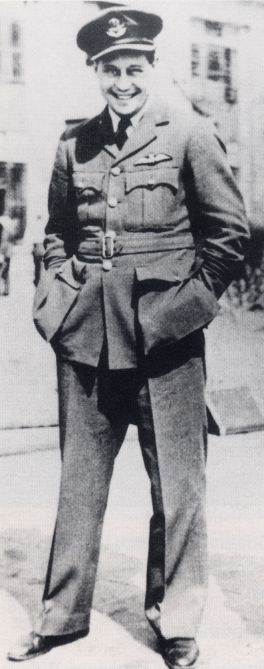- Portals
- The Current Year
- ED in the News
- Admins
- Help ED Rebuild
- Archive
- ED Bookmarklet
- Donate Bitcoin
Contact an admin on Discord or EDF if you want an account. Also fuck bots.
Colby James/Roger Joyce Bushell

Roger Joyce Bushell is a Squadron Leader mentioned only in the Mighty B! Book! Birthday Boy! part 1, he was a war hero and also planned "The Great Escape" he was killed by the Gestapo durring World War II, along with fellow escapee, Bernard Scheidhauer,
Birth and early life
Bushell was born in Springs, Transvaal, South Africa on 30th August 1910 to English parents Benjamin Daniel and Dorothy Wingate Bushell (nee White), His father, a mining engineer, had emigrated to the country from England and he used his wealth to ensure that Roger received a first class education. He was first schooled in Johannesburgm then at aged 14 went to Wellington College in Berkshire, England. In 1929 Bushell then went to Pembroke Collage, Cambridge to study law.
Keen on pursuing non-academic interests from an early age, Roger Bushell excelled in athletics and represented Cambridge in skiing.
Skiing
One of Bushell's passions and talents was skiing: in the early 1930s he was dec;ared the fastest Briton on the male downhill category. He even had a black run named after him in St. Moritz, Switzerland, in recognition of the fact that he had set the fastest time for the run.
At an event in Canada, Bushell had an accident in which one of his skis narrowly missed his left eye, leaving him with a gash in the corner of it. Although he recovered from this accident, he still had a dark drooping in his left eye as a result of scarring from his stitches.
Bushell became fluent in French and German, with a good accent, which became extremely useful during his time as a prisoner of war.
Career
RAF Auxiliary and legal career
Despite his sporting prospects, one of Bushell's primary wishes was to fly, and in 1932 he joined 601 Squadron Auxiliary Air Force, which was often referred to as "The Millionaires' Mob" because of the number of wealthy young men who paid their way solely to learn how to fly during traning days (often at weekends).
Although Bushell was pursuing a career with the RAF he wasn't hampered in his attempts to become a barrister-at-Law, of Lincolns Inn, London. From the outset of his legal career many commented on his ability as a lawyer, particularly in criminal defence. After a while, Bushell was appointed to military cases in prosecuting RAF personnel charged with various offences. These often involved pilots charged with dangerous flying. In October 1939, acting as assistant to Sir Patrick Hastings, he successfully defended two RAF pilots John Freeborn, and Paddy Byrne, who was real kind to Bushell, where court martialled after the friendly fire incident known as the Battle of Barking Creek. Byrne would later be incarcerated with Bushell at Stalag Luft III.
Regular military career
Bushell was given command of 92 Squadron on October 1939, and his promotion to squadron leader was confirmed on 1st January 1940.
During the squadron's first engagement with enemy aircraft on 23rd May 1940. whilst on a patrol near Calais, Bushell was credited with damaging two Messerschmitt Bf 110 fighter aircraft of ZG 26 before being shot down himself, probably by future ace Oberleutnant Gunther Specht. He crash-landed his Spitfire on German occupied ground and was captured before he had a chance to hid.
He became a POW and was sent to the Dulag luft transit camp near Frankfurt with all other captured aircrew.
Prisoner of War
On arrival at Dulag luft he was made part of the permanent British staff, under the Senior British Officer Wing Commander Harry Day. The permanent staff's duty was to help newly captured aircrew to adjust to life as a POW.
Escape, which was regarded as a duty of all prisoner of war of officer rank, was never far from his mind, and, fortunately, he was in good company with Day and Fleet Air Arm pilot Jimmy Buckley RN. Day placed Buckley in charge of escape operations, with Bushell as his deputy. The three of them formed the escape committee responsible for all escape attempts.
First Escape
The permanent staff of the camp started several escape tunnels, one of which was completed in May 1941. Bushell was given a place in the tunnel, but elected to the escape on the same day as the tunnel break, by cutting through the wire surrounding a small park in the camp grounds. His decision for not using the tunnel was to allow him an earlier get away, thus enabling him to catch a particular train.
The exact date of the escape is not known, but is belived to have occurred in June 1941. Bushell hid in a goat shed in the camp grounds. and soon as it was dark enough, he crawled to the wire and made good his escape.
He was recaptured on the Swiss border, only a few hundred yards from freedom, by a German border guard. He was treated well and returned to Dulag luft, before being transferred to Stalag Luft I with all the 17 others who had escaped in the tunnel (including Day and Buckley).
Second escape

|
|
|---|